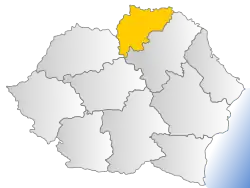Ținutul Suceava
Ținutul Suceava was one of the ten Romanian administrative regions (ținuturi) created on August 14, 1938, as a part of King Carol II's administrative reform. From August 14, 1938, to June 28, 1940, it included the whole of Bukovina, a county of Bessarabia (Hotin) and a county of Moldavia (Dorohoi). It was named after the river Suceava. Its administrative capital was the city of Cernăuți. After its northern part (the counties Cernăuți, Storojineț and Hotin, as well as parts of the counties Rădăuți and Dorohoi) was ceded to the USSR on June 28, 1940, Ținutul Suceava was restructured on September 16, 1940, when Baia county became a part of the region, and abolished only a few days latter, on September 22, 1940. Ținutul Suceava had two governors: Gheorghe Alexianu (August 14, 1938 – February 1, 1939) and Gheorghe Flondor (February 1, 1939 – September 22, 1940). Alexianu's mandate was marked by the suppression of ethnic minority and Jewish rights.[1]
Ținutul Suceava | |
|---|---|
Region (Ținut) | |
 Coat of arms | |
 | |
| Country | |
| Former counties included | Câmpulung County, Cernăuți County, Dorohoi County, Hotin County, Rădăuți County, Suceava County, Storojineț County |
| Historic region | Bukovina, Bessarabia, Moldavia |
| Administrative capital (Reședință de ținut) | Cernăuți |
| Created | August 14, 1938 |
| Abolished | September 22, 1940 |
| Government | |
| • Type | Regional governor (Rezident Regal) and regional council |
| Population | |
| • Total | circa 1.5 million |
| Time zone | UTC+2 (EET) |
| • Summer (DST) | UTC+3 (EEST) |
Coat of arms
The coat of arms consists of seven pallets, four of gules and three of azure, representing the former seven counties (județe) of Greater Romania which it included (of the total 71). Over the pallets there is a castle, representing the medieval citadel in Suceava.
Constitutive counties
The administrative reform of August 14, 1938, kept the existing 71 counties, but conveyed the marrow of their prerogatives to the news regions.
See also
References
- Philippe Henri Blasen: Suceava Region, Upper Land, Greater Bukovina or just Bukovina? Carol II’s Administrative Reform in North-Eastern Romania (1938-1940), in: Anuarul Institutului de Istorie „A. D. Xenopol”, supplement, 2015;
Philippe Henri Blasen: Terrorisme légionnaire et ordonnances antisémites. La Région Suceava d’octobre 1938 à septembre 1940, in: Archiva Moldaviae 2018.
